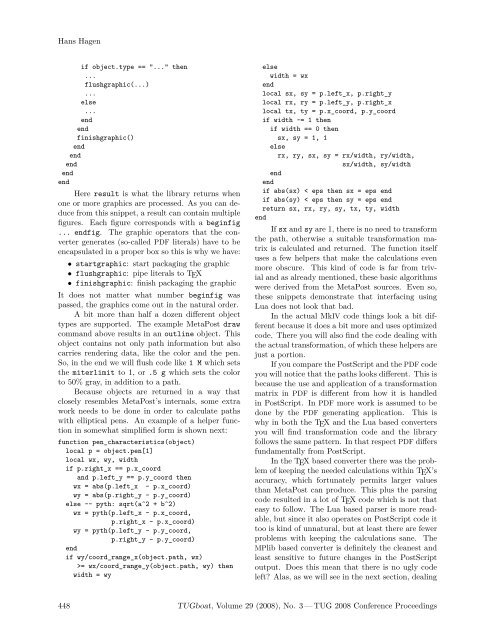The Communications of the TEX Users Group Volume 29 ... - TUG
The Communications of the TEX Users Group Volume 29 ... - TUG
The Communications of the TEX Users Group Volume 29 ... - TUG
Create successful ePaper yourself
Turn your PDF publications into a flip-book with our unique Google optimized e-Paper software.
Hans Hagen<br />
if object.type == "..." <strong>the</strong>n<br />
...<br />
flushgraphic(...)<br />
...<br />
else<br />
...<br />
end<br />
end<br />
finishgraphic()<br />
end<br />
end<br />
end<br />
end<br />
end<br />
Here result is what <strong>the</strong> library returns when<br />
one or more graphics are processed. As you can deduce<br />
from this snippet, a result can contain multiple<br />
figures. Each figure corresponds with a beginfig<br />
... endfig. <strong>The</strong> graphic operators that <strong>the</strong> converter<br />
generates (so-called PDF literals) have to be<br />
encapsulated in a proper box so this is why we have:<br />
• startgraphic: start packaging <strong>the</strong> graphic<br />
• flushgraphic: pipe literals to <strong>TEX</strong><br />
• finishgraphic: finish packaging <strong>the</strong> graphic<br />
It does not matter what number beginfig was<br />
passed, <strong>the</strong> graphics come out in <strong>the</strong> natural order.<br />
A bit more than half a dozen different object<br />
types are supported. <strong>The</strong> example MetaPost draw<br />
command above results in an outline object. This<br />
object contains not only path information but also<br />
carries rendering data, like <strong>the</strong> color and <strong>the</strong> pen.<br />
So, in <strong>the</strong> end we will flush code like 1 M which sets<br />
<strong>the</strong> miterlimit to 1, or .5 g which sets <strong>the</strong> color<br />
to 50% gray, in addition to a path.<br />
Because objects are returned in a way that<br />
closely resembles MetaPost’s internals, some extra<br />
work needs to be done in order to calculate paths<br />
with elliptical pens. An example <strong>of</strong> a helper function<br />
in somewhat simplified form is shown next:<br />
function pen_characteristics(object)<br />
local p = object.pen[1]<br />
local wx, wy, width<br />
if p.right_x == p.x_coord<br />
and p.left_y == p.y_coord <strong>the</strong>n<br />
wx = abs(p.left_x - p.x_coord)<br />
wy = abs(p.right_y - p.y_coord)<br />
else -- pyth: sqrt(a^2 + b^2)<br />
wx = pyth(p.left_x - p.x_coord,<br />
p.right_x - p.x_coord)<br />
wy = pyth(p.left_y - p.y_coord,<br />
p.right_y - p.y_coord)<br />
end<br />
if wy/coord_range_x(object.path, wx)<br />
>= wx/coord_range_y(object.path, wy) <strong>the</strong>n<br />
width = wy<br />
else<br />
width = wx<br />
end<br />
local sx, sy = p.left_x, p.right_y<br />
local rx, ry = p.left_y, p.right_x<br />
local tx, ty = p.x_coord, p.y_coord<br />
if width ~= 1 <strong>the</strong>n<br />
if width == 0 <strong>the</strong>n<br />
sx, sy = 1, 1<br />
else<br />
rx, ry, sx, sy = rx/width, ry/width,<br />
sx/width, sy/width<br />
end<br />
end<br />
if abs(sx) < eps <strong>the</strong>n sx = eps end<br />
if abs(sy) < eps <strong>the</strong>n sy = eps end<br />
return sx, rx, ry, sy, tx, ty, width<br />
end<br />
If sx and sy are 1, <strong>the</strong>re is no need to transform<br />
<strong>the</strong> path, o<strong>the</strong>rwise a suitable transformation matrix<br />
is calculated and returned. <strong>The</strong> function itself<br />
uses a few helpers that make <strong>the</strong> calculations even<br />
more obscure. This kind <strong>of</strong> code is far from trivial<br />
and as already mentioned, <strong>the</strong>se basic algorithms<br />
were derived from <strong>the</strong> MetaPost sources. Even so,<br />
<strong>the</strong>se snippets demonstrate that interfacing using<br />
Lua does not look that bad.<br />
In <strong>the</strong> actual MkIV code things look a bit different<br />
because it does a bit more and uses optimized<br />
code. <strong>The</strong>re you will also find <strong>the</strong> code dealing with<br />
<strong>the</strong> actual transformation, <strong>of</strong> which <strong>the</strong>se helpers are<br />
just a portion.<br />
If you compare <strong>the</strong> PostScript and <strong>the</strong> PDF code<br />
you will notice that <strong>the</strong> paths looks different. This is<br />
because <strong>the</strong> use and application <strong>of</strong> a transformation<br />
matrix in PDF is different from how it is handled<br />
in PostScript. In PDF more work is assumed to be<br />
done by <strong>the</strong> PDF generating application. This is<br />
why in both <strong>the</strong> <strong>TEX</strong> and <strong>the</strong> Lua based converters<br />
you will find transformation code and <strong>the</strong> library<br />
follows <strong>the</strong> same pattern. In that respect PDF differs<br />
fundamentally from PostScript.<br />
In <strong>the</strong> <strong>TEX</strong> based converter <strong>the</strong>re was <strong>the</strong> problem<br />
<strong>of</strong> keeping <strong>the</strong> needed calculations within <strong>TEX</strong>’s<br />
accuracy, which fortunately permits larger values<br />
than MetaPost can produce. This plus <strong>the</strong> parsing<br />
code resulted in a lot <strong>of</strong> <strong>TEX</strong> code which is not that<br />
easy to follow. <strong>The</strong> Lua based parser is more readable,<br />
but since it also operates on PostScript code it<br />
too is kind <strong>of</strong> unnatural, but at least <strong>the</strong>re are fewer<br />
problems with keeping <strong>the</strong> calculations sane. <strong>The</strong><br />
MPlib based converter is definitely <strong>the</strong> cleanest and<br />
least sensitive to future changes in <strong>the</strong> PostScript<br />
output. Does this mean that <strong>the</strong>re is no ugly code<br />
left? Alas, as we will see in <strong>the</strong> next section, dealing<br />
448 <strong>TUG</strong>boat, <strong>Volume</strong> <strong>29</strong> (2008), No. 3 — <strong>TUG</strong> 2008 Conference Proceedings

















